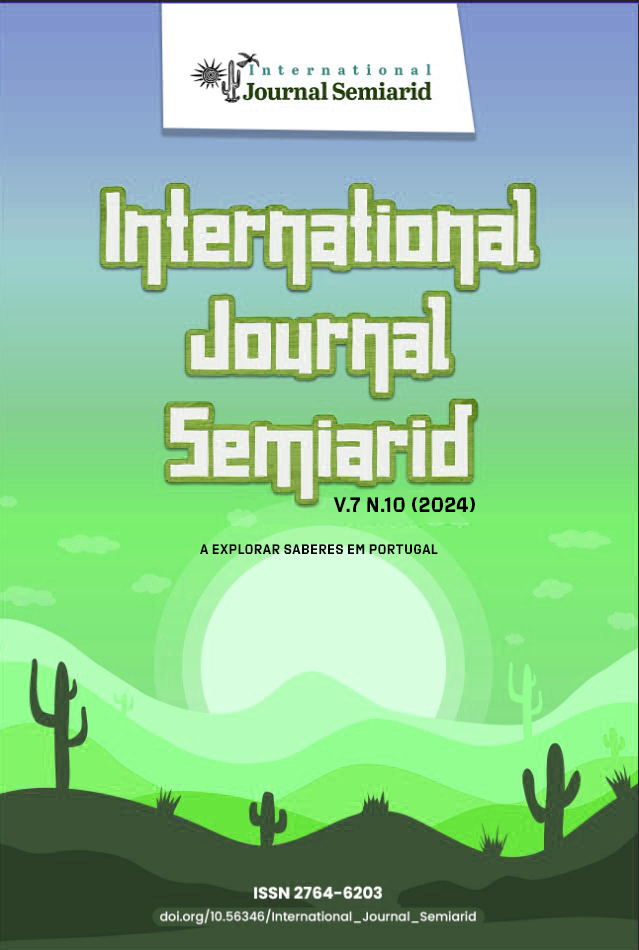DIVERSIDADE, GESTÃO E RECUPERAÇÃO DE COMUNIDADES VIVAZES EM PORTUGAL CONTINENTAL
DOI:
https://doi.org/10.56346/ijsa.v7i10.290Palavras-chave:
conservação, desertificação, flora, pastagens, vegetação.Resumo
Os arrelvados vivazes constituem habitats de alguma fragilidade, quando não adequadamente geridos. Por outro lado, estão relacionados com uma elevada diversidade florística, constituindo refúgio de biodiversidade, abrigando espécies endémicas. É apresentada uma revisão, descrição e caracterização de alguns tipos de arrelvados vivazes acidófilos, mesofíticos que correspondem a subtipos prioritários de habitats protegidos em contexto Europeu. Estes habitats estão presentes em Portugal continental e incluídos nas classes de vegetação: Celtico giganteae-Agrostietea castellanae e Poetea bulbosae. São analisadas as pressões e ameaças, bem como possíveis medidas de conservação, relacionadas com as práticas de gestão. É também abordada a possível necessidade de ações de recuperação.
Referências
Benayas JMR, Newton AC, Diaz A, Bullock JM. 2009. Enhancement of Biodiversity and Ecosystem Services by Ecological Restoration: A Meta-Analysis. Science 325 (5944): 1121-1124.
Castroviejo, S. (coord. gen.). 1986-2015. Flora iberica 1-9, 10-16(1), 17-18, 20-21. Real Jardín Botánico, CSIC, Madrid, ES.
Costa, J.C., Neto, C., Aguiar, C., Capelo, J., Espírito-Santo, M.D., Honrado, J., Pinto-Gomes, C., Monteiro-Henriques, T., Sequeira, M. & Lousã, M. 2012. Plants communities of vascular plants of Portugal (Continental, Azores and Madeira). Global Geobotany 2: 1-180.
Díaz Lifante Z. & Benito V. 1996. Revision del genero Asphodelus L. (Asphodelaceae) en el Mediterraneo Occidental. Boissiera 52: 7-186.
Dullinger, S. Dirnbock, T. Greimler, J. & Grabherr, G. 2003. A resampling approch for evaluating effects of pasture abandonment on subalpine plant species diversity. Journal of Vegetation Science 14: 243-252.
EC (European Commission). 2007. The interpretation manual of European Union habitats - EUR27. Brussels: European Commission DG Environment. http://ec.europa.eu/environment/
Hellström, k., Huhta, A.-P., Rautio, P., Tuomi,J., Okksanen, J. & Laine, K. 2003. Use of sheep grazing in the restoration of semi-natural meadows in northern Finland. Applied Vegetation Science 6: 45-52.
Hoffmann, M. & Isselstein, J. 2004. Seedling recruitment on agriculturally improved mesic grassland: the influence of disturbance and management. Applied Vegetation Science 7: 193-200.
ICNB. 2006. Plano Sectorial da Rede Natura 2000. Caracterização de Valores Naturais. Instituto da Conservação da Natureza. http://www2.icnf.pt/portal/pn/biodiversidade/rn2000/p-set/hab-1a9 nature/legislation/habitatsdirective/docs/2007_07_im.pdf.
Isselstein, J., Jeangros, B. & Pavlu, V. 2005. Agronomic aspects of biodiversity targeted management of temperate grasslands in Europe – A review. Agronomy Research 3(2): 139-151.
Janišová, M, Bartha, S, Kiehl, K, Dengler, J., 2011. Advances in the conservation of dry grasslands: Introduction to contributions from the seventh European Dry Grassland Meeting. Plant Biosystems 145 (3): 507-513.
Madruga-Andreu C, Plaixats J, López-i-Gelats F, Bartolomé J. 2011. Medium-term success of revegetation methods for high-mountain grassland reclamation in the Montseny Biosphere Reserve (NE Spain). Plant Biosystems 145: 738–749.
McNaughton S. J. 1984. Grazing lawns: animals in herds, plant form, and coevolution. American Naturalist 124: 863-886.
Moreira, N.; Aguiar, C. & Pires, J.M. (2001) - Lameiros e outros prados e pastagens de elevado valor florístico. Pastagens de Montanha. Direcção Geral de Desenvolvimento Rural. Lisboa. 47pp.
Olff H. & Ritchie M. E. 1998. Effects of herbivores on grassland plant diversity. Trends in Ecology and Evolution 13: 261-265.
Peco B., de Pablos I., Traba J. & Levassor C. 2005. The effect of grazing abandonment on species composition and functional traits: the case of dehesa grasslands. Basic and Applied Ecology 6(2): 175-183.
Prach, K, Jongepierová, I, Řehounková, K, Fajmon, K, 2014. Restoration of grasslands on ex-arable land using regional and commercial seed mixtures and spontaneous succession: Successional trajectories and changes in species richness. Agriculture, Ecosystems and Environment 182: 131-136.
Pykälä J. 2000. Mitigating human effects on European biodiversity through traditional animal husbandry. Conservation Biology 14 (3): 705-712.
Pykälä J. 2003. Effects of restoration with cattle grazing on plant species composition and richness of semi-natural grasslands. Biodiversity and Conservation 12: 2211-2226.
Ribeiro, S. & Espírito-Santo, M. D. 2015. Dinâmica de comunidades herbáceas no CE & SE de Portugal continental (Beira Interior e Alentejo). Guineana 21:1-212. ISSN 1135-7924.
Ribeiro, S., Delgado, F. & Espírito-Santo, M. D. 2012. Comunidades de Asphodelus bento-rainhae: diversidade, ecologia e dinâmica serial. Silva Lusitana 20(1/2): 135-143. ISSN 0870-6352
Ribeiro, S., Fernandes, J. P. & Espírito-Santo, M. D. 2014. Diversity and floristic patterns of Mediterranean grasslands: The relative influence of environmental and land management factors. Biodiversity & Conservation 23: 2903-2921. DOI 10.1007/s10531-014-0754-y
Ribeiro, S., Gonçalves, P. & Espírito-Santo, M. D. 2012. Land-use influence on Mediterranean perennial swards of Poa bulbosa: a case study in the International Tagus Region. Lazaroa 33: 51-64. Doi: 10.5209/rev_LAZA.2012.v33.40286.
Ribeiro, S., Ladero, M. & Espírito-Santo, M. D. 2013. Patterns of floristic composition of Mediterranean meadows and mesophytic grasslands in eastern Continental Portugal. Plant Biosystems 147(4): 874-892: 1-19. DOI: 10.1080/11263504.2013.788571.
Ribeiro, S., Simões, M., Felizes, F., Monteiro, A. 2019. Restoration of European habitats in mainland Portugal, using commercial seed mixtures. Considerations for its management and conservation. Plant Biosystems 153 (3): 352-359. DOI: 10.1080/11263504.2018.1478905.
Rivas-Martínez, S., Penas, A., del Rio, S., Diaz, T.E., Herrero, L., Pinto-Gomes, C. & Costa, J.C. 2014. Biogeography of Spain and Portugal. Preliminary typological analysis. International Journal of Geobotanical Research 4: 1-64.
Rudmann-Maurer K., Weyand A., Fisher M. & Stöcklin J. 2008. The role of landuse and natural determinants for grassland vegetation composition in the Swiss Alps. Basic and Applied Ecology 9(5): 494-503.
Salgueiro, T.A. (2008) - As pastagens - passado, presente e futuro. Revista de Ciências Agrárias 31 (1): 271-282.
Scotton M, Kirmer A, Krautzer B (Eds.). 2012. Practical Handbook for Seed Harvestand Ecological Restoration of Species-Rich Grasslands. Cleup, Padova.
Török P, Deák B, Vida E, Valkó O, Lengyel S, Tóthmérész B. 2010. Restoring grassland biodiversity: Sowing low-diversity seed mixtures can lead to rapid favourable changes. Biological Conservation 143: 806-812.
Vázquez F. M. & Barkworth M. E. 2004. Resurrection and emendation of Macrochloa (Gramineae: Stipeae). Botanical Journal of the Linnean Society 144: 483-495.
White R., Murray S., Rohweder M. 2000. Pilot Analysis of Global Ecosystems: Grassland Ecosystems. World Resources Institute. Washington.
Zimkova M, Kirilov A, Rotar I, Stypinski P. 2007. Production and quality of seminatural grassland in South-eastern and Central Europe. In: VlieghereCarlier (Eds.) - Permanent and Temporary Grassland – Plant, Environment and Economy.Grassland Science in Europe 12: 15-26.


